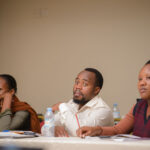In December 1993, the residents of Marinduque, an island province in the Philippines, were preparing to weather Typhoon Lola. After the storm had passed, they assumed the worst was behind them. Instead, they faced an environmental disaster: a nearby dam operated by Marcopper, a Canadian mining corporation, had burst, flooding several towns with toxic water. The floods damaged and destroyed homes and agriculture. Two children died. But the mining company shrugged off any responsibility.
The communities turned to local activists and environmental groups, including the Legal Rights and Natural Resources Center (LRC), a Fund grantee that provides legal and campaigning support to help Indigenous peoples and rural communities protect their land and natural resources. LRC helped the villagers launch a court case. For the past 10 years, the Fund’s financial support has helped them keep the case moving through the sluggish court system.
This May, a regional court ruled that Marcopper’s negligence was to blame for the disaster and ordered the corporation to pay more than 6 million Philippine pesos (US$107,000), mostly in restitution to 30 affected families. LRC’s joy at the verdict was tempered by the fact that it came nearly 30 years after the flooding claimed people’s homes and children. “The case took decades to win. Justice delayed is still justice denied,” says Mai Taqueban, lawyer with LRC. “Some of the complainants have died of old age and will not be able to reap benefits from this win.”
LRC will continue to monitor the case, including countering any appeals from the mining company and making sure the funds are paid to families. They also hope this victory will bolster further efforts to hold the mining sector and other industries accountable for damage to the environment and people’s land and livelihoods. (The same company faces additional cases for a spill three years later that’s considered the country’s worst environmental disaster.)
“This is definitely historic and an emblematic case. It serves as warning to mining companies that we could run after them and for affected communities to have hope and not be afraid to stand up for their land,” says Mai.
The case is a powerful example of the difference made by the type of long-term, flexible support provided by the Fund. Environmental and human rights cases like these demand legal teams who can dedicate their time and focus for years. That’s why we often say the Fund is in it for the long haul, supporting the activists who won’t stop until they’ve achieved justice.


